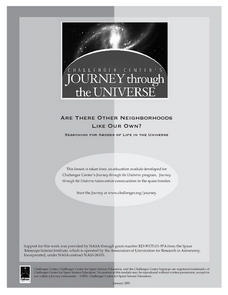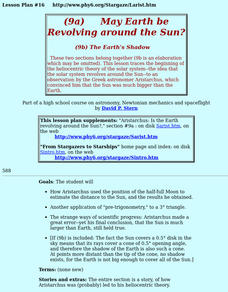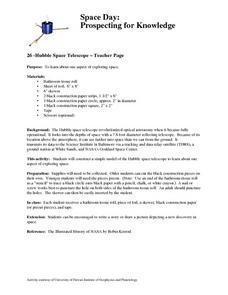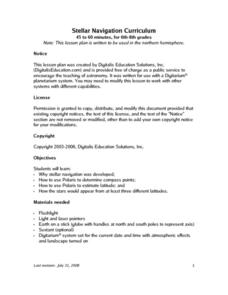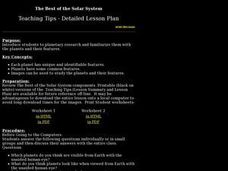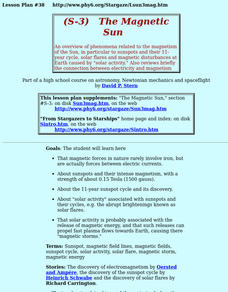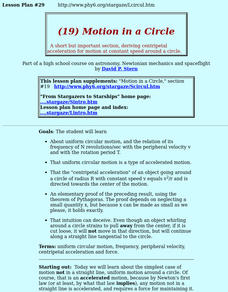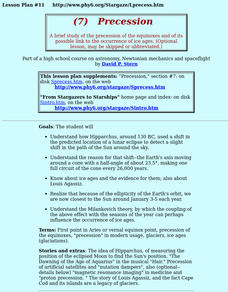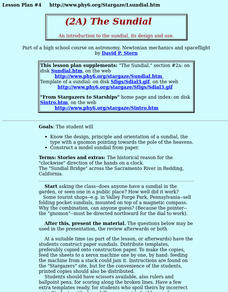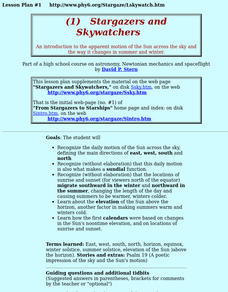Curated OER
Constellations
Students explore constellations. They read trade books about constellations and write notes including their locations, origins, and names. They research and report on one constellation in the Northern Hemisphere and share their report...
Curated OER
Are There Other Neighborhoods Like Our Own?
Students investigate the possibility of life existing on other planets. They conduct research using a variety of resources. The lesson includes an overview that is used for classroom discussion practices. They tell the teacher how to...
Curated OER
The Nebraska Brochure
Students research the physical attributes of Nebraska. They work together to create a brochure highlighting the topic of their choice. They share their brochure to the class.
Curated OER
Model Professionals
Students learn about one scientist's quest to make her field of canopy ecology accessible to a wider audience and to synthesize their knowledge by developing toy figures that could potentially educate children about different scientific...
Curated OER
Puzzling Planets
Students list the order of the planets, describe the general characteristics of each planet and explain why we could not live on other planets without special equipment.
Curated OER
Powers of 10
Students explore universe, and examine how big it really is and how scientists measure the distances or sizes of things by estimating sizes of different objects and reading and writing numbers in scientific notations.
Curated OER
LIFE IN SPACE Human Body: An Un-Earthly Home
Learners examine an effect of zero gravity on the human body using a baby food jar, balloons and a jar with a large mouth.
Curated OER
May The Earth Be Revolving Around The Sun?
Learners trace the beginning of the heliocentric theory of the solar system--the idea that the solar system revolves around the Sun--to an observation by the Greek astronomer Aristarchus, which convinced him that the Sun was much bigger...
Curated OER
May Earth be Revolving around the Sun?
Ninth graders explore how Aristarchus used the position of the half-full Moon to estimate the distance to the Sun, and how he made a great error, but still figured out that the Sun is much larger than Earth.
Curated OER
Liquid Crystal IR Detector
Students experiment with one method of detecting infrared radiation. They simulate the detection of infrared radiation using a liquid crystal sheet.
Curated OER
Football Physics "Having A Ball With Projectile Motion"
Students examine the concept of projectile motion and identify the 3 components of projectile motion. They explore how physics applies to punting a football through punting activities and internet research.
Curated OER
Spacd Day:Probing For Knowledge
Students investigate the uses and purpose of the Hubble telescope. They create a model of the telescope and conduct research about the history behind the invention of it. Students use the information in order to create a context for the...
Curated OER
Stellar Navigation Curriculum
Students investigate the concept of star mapping and how it is used in space navigation. They conduct various activities to see the effect of mapping. Also the teacher uses models and demonstrations in order to communicate the main...
Curated OER
Lives of Stars
Students take notes on the lives of stars. In this lesson on stars, students take notes alongside a PowerPoint presentation about the lives of stars.
Curated OER
Planetary Research (Grades 9-12)
Students are introduced to planetary research and familiarize them with the planets and their features. They see that each planet has unique features. Planets have some common features and that images can be used to study the planets and...
Curated OER
Seeing The Sun In A New Light
Students examine the observation of "coronal holes," by x-rays, also about related fast streams and moderate magnetic storms that recur at 27 day intervals. They study NASA'S great observatories.
Curated OER
(S-1) Sunlight and the Earth
High schoolers discuss the solar heating of the Earth and atmosphere, its heat loss proceses, and the way these relate to weather and climate.
Curated OER
#24 Rotating Frames of Reference in Space and on Earth
Learners explore rotating frames of reference, focusing on the weightless environment in space and the Coriolis force.
Curated OER
#22c Airplane flight #22d Airplane flight--How High? How Fast?
Students discuss the application of frames of reference to an airplane flying with a constant velocity v through the air.
Curated OER
Motion in a Circle
High schoolers study about deriving centripetal acceleration for motion at constant speed around a circle.
Curated OER
Precession
Students explain how Hipparchus, around 130 BC, used a shift in the predicted location of a lunar eclipse to detect a slight shift in the path of the Sun around the sky. They examine the elliptical orbit in which the Earth travels around...
Curated OER
The Sundial
Students explain the design, principle and orientation of a sundial, the type with a gnomon pointing towards the pole of the heavens. They construct a model sundial from paper.
Curated OER
Stargazers And Skywatchers
Pupils recognize the daily motion of the Sun across the sky, defining the main directions of east, west, south and north. They see how the first calendars were based on changes in the Sun's noontime elevation, and on locations of sunrise...
Other popular searches
- Astronomy and Space Science
- Space Science Astronomy
- Science Astronomy Stars
- Earth Science Astronomy
- Science Astronomy Graphing
- Life Science Astronomy
- "Astronomy and Space Science



